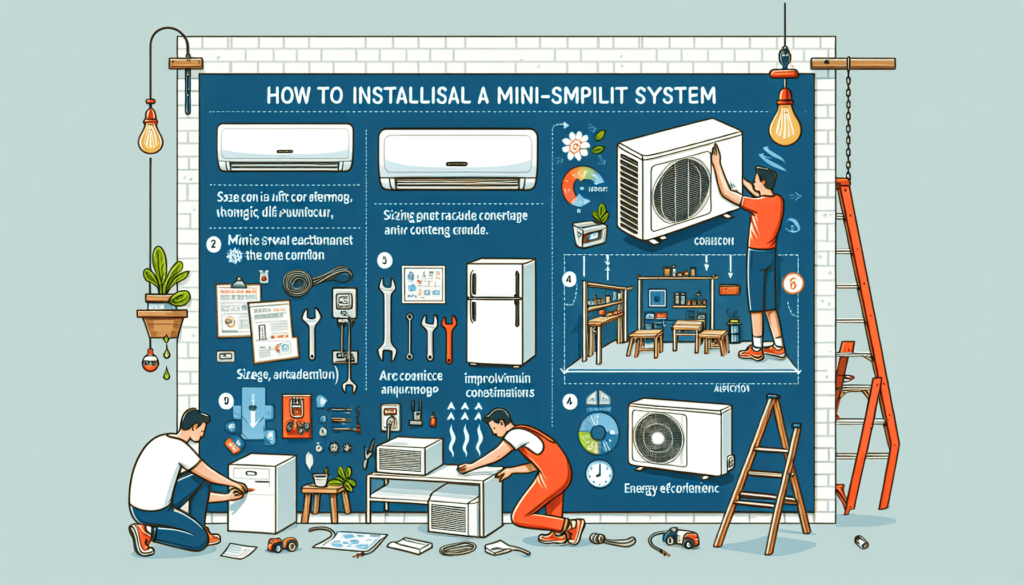So you’ve finally decided to upgrade your garage or workshop with a mini split system, but you’re unsure of where to start. Look no further! This comprehensive guide will walk you through every step of the installation process, making it a breeze for even the most inexperienced DIY-er. From selecting the right system for your space to wiring and mounting the unit, we’ve got you covered. Say goodbye to sweltering summers and freezing winters in your workspace, and say hello to the perfect temperature all year round. Let’s get started!

Understanding The Need Of Mini Split System In Garage Or Workshop
Why install a mini split in your garage or workshop?
Installing a mini split system in your garage or workshop comes with several benefits. Firstly, it allows you to have control over the temperature and climate in your space. This is especially important in a garage or workshop where you may be working on projects that require a specific temperature range.
Secondly, a mini split system helps to improve air quality. Garages and workshops can often have poor ventilation, leading to dust, fumes, and other contaminants circulating in the air. A mini split system with a proper filtration system can help to eliminate these pollutants, creating a cleaner and healthier working environment.
Lastly, a mini split system is energy efficient. Unlike traditional HVAC systems, mini splits are designed to cool or heat individual zones or rooms. This means you can adjust the temperature to suit your needs without wasting energy on cooling or heating the entire space. This can lead to significant savings on your energy bills in the long run.
Benefits of a mini split system
There are several benefits to installing a mini split system in your garage or workshop.
First and foremost, mini split systems are compact and easy to install. They consist of two main components – the indoor unit and the outdoor unit. The indoor unit can be mounted on the wall or ceiling, while the outdoor unit is usually placed outside the building. This makes mini split systems a convenient option for smaller spaces like garages or workshops.
Another advantage of mini split systems is that they provide both cooling and heating capabilities. This means you can use them year-round, regardless of the season. Whether you need to cool down in the summer or warm up in the winter, a mini split system can provide you with the desired comfort.
Mini split systems also offer flexibility when it comes to zoning. You can divide your garage or workshop into different zones and control the temperature independently in each zone. This is especially useful if different areas of your space have varying temperature requirements.
Additionally, mini split systems are known for their quiet operation. The noise level is significantly lower compared to traditional HVAC systems, ensuring a peaceful and comfortable working environment.
Choosing The Right Mini Split System
Determining the right size
Before purchasing a mini split system for your garage or workshop, it’s important to determine the right size for your space. The cooling and heating capacity of a mini split system is measured in British Thermal Units (BTUs). Choosing a system with the correct BTU rating ensures optimal performance and energy efficiency.
To determine the right size, you’ll need to consider the size of your garage or workshop, the insulation, the number of windows and doors, and the climate in your area. There are various online calculators and sizing guides available to assist you in finding the appropriate BTU rating for your space.
Choosing between different brands
When it comes to choosing a mini split system, there are several reputable brands to consider. It’s important to research and compare different brands based on factors such as reliability, energy efficiency, and customer reviews.
Some popular brands in the mini split system market include Mitsubishi Electric, Daikin, LG, Fujitsu, and Panasonic. Each brand offers its own unique features and benefits, so it’s worth exploring the options and determining which one aligns best with your needs and preferences.
Comparing features of different models
Within each brand, there are various models of mini split systems available. It’s important to compare the features of different models to find the one that suits your requirements.
Key features to consider include energy efficiency ratings, advanced filtration systems, remote control options, and smart technology integration. Think about what features are important to you and prioritize accordingly.
Pre-Installation Considerations
Selecting the perfect location for indoor and outdoor units
Before installing the mini split system, you need to carefully select the location for both the indoor and outdoor units. The indoor unit should be placed in a location that allows for optimal airflow and even distribution of conditioned air throughout the space. It’s ideal to mount it on a wall or ceiling where it won’t obstruct any work areas.
Similarly, the outdoor unit should be placed in an area with proper clearance and ventilation. It should be positioned away from obstructions such as trees, bushes, or structures that could restrict airflow.
Ensuring you have all necessary tools and equipment
Before starting the installation process, it’s important to ensure that you have all the necessary tools and equipment. Some common tools and materials you may need include a drill, screwdriver, level, mounting brackets, refrigerant piping, electrical wiring, and insulation tape.
It’s also essential to have appropriate personal protective equipment (PPE) such as gloves, safety goggles, and a mask to protect yourself during the installation process.
Understanding local regulations and obtaining necessary permits
Another crucial consideration is to understand the local regulations and obtain any necessary permits for installing a mini split system in your garage or workshop. Regulations may vary depending on your location, so it’s important to check with your local authority or consult with a professional to ensure compliance with codes and regulations.
Purchasing The Mini Split System
Where to buy the mini split system from
There are several options for purchasing a mini split system. You can buy from authorized dealers of specific brands, HVAC retailers, or even online marketplaces. It’s important to ensure that you are buying from a reputable source to guarantee the authenticity and warranty of the product.
Authorized dealers often provide professional advice and assistance in selecting the right system for your needs. They can also offer installation services if you prefer to have the system installed by experts.
Checking warranty and support before purchasing
Before finalizing your purchase, it’s crucial to check the warranty and support offered by the manufacturer. Mini split systems typically come with a warranty that covers the compressor and other components for a certain period of time. Ensure that you understand the terms and conditions of the warranty and that it provides adequate coverage.
Additionally, check if the manufacturer provides technical support or assistance in case of any issues or questions that may arise during installation or operation of the system.

Unpacking The Mini Split System
Safety precautions while unpacking
When unpacking the mini split system, it’s important to take necessary safety precautions. Ensure that you have a clean and clear workspace. Use caution while handling sharp objects such as box cutters or scissors, and avoid rushing the unpacking process to prevent accidents or damage to the components.
Inspecting components for any damage or missing parts
Before proceeding with the installation, thoroughly inspect all the components of the mini split system for any damage or missing parts. Check the indoor and outdoor units, as well as accessories such as remote control, filters, and mounting brackets. If any damage or missing parts are found, contact the manufacturer or supplier to resolve the issue before installation.
Installing The Outdoor Unit
Determining the location
Once you have unpacked and inspected the components, it’s time to install the outdoor unit. Choose a suitable location for the outdoor unit that meets the manufacturer’s guidelines and local regulations. Ensure that there is proper clearance around the unit for maintenance and airflow.
Mounting the bracket
Before installing the outdoor unit, mount the bracket on a sturdy surface such as the wall or a concrete pad. Use appropriate fasteners and make sure the bracket is securely attached.
Installing the outdoor unit
Carefully lift the outdoor unit and place it on the mounted bracket. Ensure that it is level and secure. Connect the electrical wiring according to the manufacturer’s instructions and guidelines. Double-check all connections to ensure they are properly tightened.
Preparing The Indoor Unit
Identifying where to mount the indoor unit
Before installing the indoor unit, identify the optimal location for mounting. Consider factors such as the layout of your space, airflow distribution, and accessibility for maintenance and cleaning.
Drilling hole for refrigerant piping
To connect the indoor and outdoor units, you will need to drill a hole for the refrigerant piping. Carefully choose the location for the hole, ensuring it is at the correct height and size as specified by the manufacturer. Use an appropriate drill bit and follow all safety guidelines.
Mounting the indoor unit bracket
After drilling the hole, mount the indoor unit bracket on the wall or ceiling using the provided screws and anchors. Ensure that the bracket is level and secure to support the weight of the indoor unit.
Installing The Indoor Unit
Connecting the refrigerant lines
Carefully connect the refrigerant lines from the outdoor unit to the indoor unit through the drilled hole. Follow the manufacturer’s instructions for proper connection and use appropriate fittings and insulation to prevent any refrigerant leakage.
Securing the indoor unit
Once the refrigerant lines are connected, securely mount the indoor unit on the bracket. Ensure that it is level and securely fastened to the bracket to prevent any vibrations or movement.
Connecting The Indoor And Outdoor Units
Routing the refrigerant lines
After securing the indoor unit, route the refrigerant lines from the outdoor unit to the indoor unit. Ensure that the lines are properly supported and protected from any potential damage or interference.
Recapping and closing the hole
After routing the refrigerant lines, close the hole by using suitable sealing materials to prevent any air leakage or water intrusion. Ensure that the sealing is secure and tight.
Finalizing The Installation And Testing
Adding Refrigerant
After completing the installation, it is important to add the appropriate amount of refrigerant to the system. This should be done by a professional installer or HVAC technician who is certified to handle refrigerants safely.
Testing the unit
Once the refrigerant is added, it’s time to test the mini split system. Turn on the system and check for any leaks, unusual noises, or malfunctions. Test the cooling and heating functionality to ensure that everything is working properly.
Cleaning and tidying up after installation
After testing, clean up any debris or waste generated during the installation process. Ensure that the area is tidy and safe for use. Dispose of any packaging materials or unused components responsibly.
In conclusion, installing a mini split system in your garage or workshop can provide you with a comfortable and controlled working environment. By understanding the need for a mini split system, choosing the right system for your space, considering pre-installation factors, purchasing from reputable sources, and following the step-by-step installation process, you can enjoy the benefits of a reliable and efficient cooling and heating solution for your garage or workshop.

